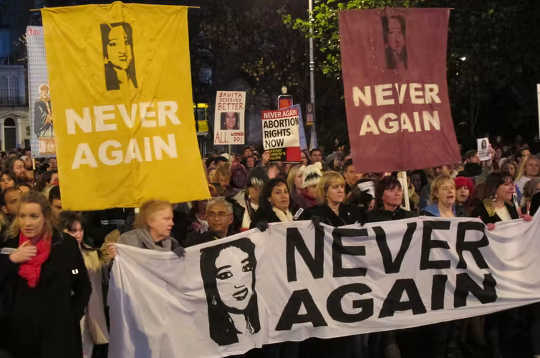
The death of Savita Halappanavar in an Irish hospital in 2012 after she was denied an abortion during a miscarriage caused outrage across Ireland. AP Photo/Shawn Pogatchnik
If the U.S. Supreme Court overturns Roe v. Wade, the 1973 decision that legalized abortion in the U.S., the nation may find itself on a path similar to that trod by the Irish people from 1983 to 2018. A draft decision signed by the majority of conservative justices was leaked in May 2022, and indicates the court may do just that.
Abortion was first prohibited in Ireland through what was called the Offenses Against the Person Act of 1861. That law became part of Irish law when Ireland gained independence from the U.K. in 1922. In the early 1980s, some anti-abortion Catholic activists noticed the liberalization of abortion laws in other Western democracies and worried the same might happen in Ireland.
Various Catholic organizations, including the Irish Catholic Doctors’ Guild, St. Joseph’s Young Priests Society and the St. Thomas More Society, combined to form the Pro Life Amendment Campaign. They began promoting the idea of making Ireland a model anti-abortion nation by enshrining an abortion ban not only in law but in the nation’s constitution.
As a result of that effort, a constitutional referendum passed in 1983, ending a bitter campaign where only 54% of eligible voters cast a ballot. Ireland’s eighth constitutional amendment “acknowledges the right to life of the unborn and [gave] due regard to the equal right to life of the mother.”
This religiously motivated anti-abortion measure is similar to religiously oriented anti-abortion laws already on the books in some U.S. states, including Texas, which has a ban after six weeks of pregnancy, and Kentucky, which limits private health insurance coverage of abortion.
What happened over the 35 years after the referendum passed in Ireland was a battle to legalize abortion. It included several court cases, proposed constitutional amendments and intense advocacy, ending in 2018 with another referendum, re-amending the Irish constitution to legalize abortion up to 12 weeks gestation.
Real-life consequences
Even before 1983, people who lived in Ireland who wanted a legal abortion were already traveling to England on what was known as the “abortion trail”, as abortion was also criminalized in Northern Ireland. In the wake of the Eighth Amendment, a 1986 Irish court ruling declared that even abortion counseling was prohibited.
A key test of the abortion law came in 1992. A 14-year-old rape victim, who became pregnant, told a court she was contemplating suicide because of being forced to carry her rapist’s baby. The judge ruled that the threat to her life was not so great as to justify granting permission for an abortion. That ruling barred her from leaving Ireland for nine months, effectively forcing her to carry the pregnancy to term.
On appeal, a higher court ruled that the young woman’s suicidal thoughts were in fact enough of a life threat to justify a legal termination. But before she could have an abortion, she miscarried.
The case prompted attempts to pass three more amendments to Ireland’s constitution. One, declaring that suicidal intentions were not grounds for an abortion, failed. The other two passed, allowing Irish people to travel to get an abortion, and allowing information to be distributed about legal abortion in other countries.
Emergency treatment
Even with these adjustments, the Eighth Amendment sometimes restricted the ability of medical professionals to offer patients life-saving care during a pregnancy-related emergency.
In 2012, Savita Halappanavar, age 31 and 17 weeks pregnant, went to a hospital in Galway, Ireland. Doctors there determined that she was having a miscarriage. However, because the fetus still had a detectable heartbeat, it was protected by the Eighth Amendment. Doctors could not intervene – in legal terms, ending its life – even to save the mother. So she was admitted to the hospital for pain management while awaiting the miscarriage to progress naturally.
Over the course of three days, as her pain increased and signs of infection grew, she and her husband pleaded with hospital officials to terminate the pregnancy because of the health risk. The request was denied because the fetus still had a heartbeat.
By the time the fetal heartbeat could no longer be detected, Halappanavar had developed a massive infection in her uterus, which spread to her blood. After suffering organ failure and four days in intensive care, she died.
This was likely not the only time someone had suffered, or even died, as a result of being denied abortion in Ireland. But the publicity surrounding the case prompted a new wave of activism aimed at repealing the Eighth Amendment. In 2013, the Protection of Life During Pregnancy Act was signed into law, which did not fully repeal the Eighth Amendment but legalized abortions that would protect the mother’s life.
It is estimated that about 170,000 people traveled from Ireland to seek a legal abortion between 1980 and 2018.
In 2018, a referendum repealing the Eighth Amendment passed overwhelmingly by a margin of 66% to 34%. As a result of the repeal, legal abortions are now allowed during the first trimester, with costs covered by the public health service.
A similar situation in the US
As a social work professor who researches reproductive health care, I see many parallels between what happened in Ireland between 1983 and 2018 and the present U.S. situation.
People in the U.S. are already traveling long distances, often to other states, in a manner similar to the Irish abortion trail.
In both the U.S. and Ireland, the people who need help paying for abortions are mostly single people in their 20s who already have an average of two children, according to research I conducted with some abortion funds, which are charitable organizations that help people cover often-unaffordable abortion expenses.
In contrast to the United States, Ireland is moving away from political control over private life. If Roe is reversed and abortion is criminalized in much of the U.S., pregnant people could face decades of forced pregnancy, suffering and even death – as was the case in Ireland prior to 2018.![]()
About The Author
Gretchen E. Ely, Professor of Social Work and Ph.D. Program Director, University of Tennessee
This article is republished from The Conversation under a Creative Commons license. Read the original article.
Related Books:
The Body Keeps the Score: Brain Mind and Body in the Healing of Trauma
by Bessel van der Kolk
This book explores the connections between trauma and physical and mental health, offering insights and strategies for healing and recovery.
Click for more info or to order
Breath: The New Science of a Lost Art
by James Nestor
This book explores the science and practice of breathing, offering insights and techniques for improving physical and mental health.
Click for more info or to order
The Plant Paradox: The Hidden Dangers in "Healthy" Foods That Cause Disease and Weight Gain
by Steven R. Gundry
This book explores the links between diet, health, and disease, offering insights and strategies for improving overall health and wellness.
Click for more info or to order
The Immunity Code: The New Paradigm for Real Health and Radical Anti-Aging
by Joel Greene
This book offers a new perspective on health and immunity, drawing on principles of epigenetics and offering insights and strategies for optimizing health and aging.
Click for more info or to order
The Complete Guide to Fasting: Heal Your Body Through Intermittent, Alternate-Day, and Extended Fasting
by Dr. Jason Fung and Jimmy Moore
This book explores the science and practice of fasting offering insights and strategies for improving overall health and wellness.






















